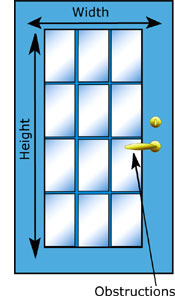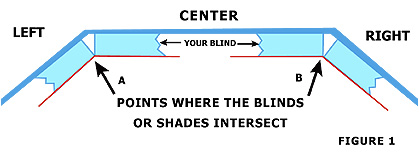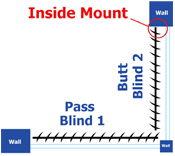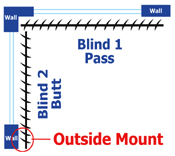How To Measure For Window Shades And Blinds
How to measure for Blinds and shades (Printable)
How to Measure your Windows
General Overview:
Measuring your windows for Blinds, Shades or Interior Shutters is easy. Let'due south start with a few general rules that utilize to all of the window treatments nosotros sell. Remember, it'southward best to measure TWICE and gild ONCE.
Rule 1:
Always use a steel tape measure. Never try to measure your windows with a cloth record, ruler or yardstick.
Rule 2:
Measure downward to the nearest eighth of an inch and do not round your measurements. Meaning don't measure 35 3/8″ and call it 35″ or 36″.
Rule three:
When writing down your measurements be sure to betoken which measurement is the width and which is the height and ALWAYS notation the width first, then the meridian. A common mistake customers make is transposing the numbers. Be sure not to become them backwards. Since these are custom fabricated products it'south generally very hard to have a size modified and can get costly to have them remade.
Measuring Instance: your window is 36 three/8″ wide by lx 1/four″ high (tall). Recollect of it in these terms, Width is horizontal (horizon) left to correct and tiptop is vertical peak to bottom. Your written measurements would look something like this… 36 3/8″ x 60 1/4″
Rule iv:
Inside Mount Only – Do NOT take any deductions . Our factory takes those allowances. You need to provide the states with your EXACT WINDOW SIZE OPENING, do non utilise the size of an existing blind in that window. If you take your ain deductions and then society every bit an within mount you will become a double deduction when the mill also takes an allowance meaning your window treatment volition non fit properly and you will have a larger gap between the treatment and the window opening.
Dominion five:
Outside Mount Only – Y'all need to provide the exact overall bullheaded size needed (past adding the necessary coverage to the width and meridian of opening). Our factory makes most outside mount blinds the exact width and tiptop y'all specify. NOTE: The height includes the OVERALL bullheaded which includes the headrail, etc. One of the few exceptions are roller shades which the width is mostly made as a tip-to-tip size. Meaning the cloth width is generally smaller than the width of the roller tube and bracket tabs. Since at that place is more often than not no deductions fabricated on exterior mount blinds, exercise not order your blinds as an outside mount if you are installing them inside a window opening as they will not fit. The bullheaded cannot be the same exact size as the window it will exist installed in as at that place must be room for hardware and clearance. Outside mountain applications are usually used for windows that practice not have an inside area, like a patio sliding glass door for example.
 Choose Inside or Exterior Mount:
Choose Inside or Exterior Mount:
Before taking any measurements, step dorsum from your window and decide if you want to mount the window treatment within the window recess or outside on the wall or molding. For an inside mount, the window opening must accept plenty unobstructed depth to allow mounting. Be certain to expect for obstructions like window locks, window cranks, etc.
Tip: For a flush inside mountain (the blind completely recessed so that no function of the blind projects out of the opening) check that you have plenty depth and make sure that if a valance is included that nosotros make it slightly smaller than the window opening width since they are normally fabricated an inch or two wider.
Tip: We usually recommend an inside mount whenever possible because it provides a cleaner look. All the same, an outside mount tin can make a window appear larger or hibernate an unattractive window. When yous specify inside mount, we will brand a size deduction to allow for operating clearance. With most products we will deduct up to one/4″ from each side. Roller shades likewise have a rather large material and roller tube deduction (come across product specs tab on product pages). For vertical blinds there is besides a height deduction of 1/4″. The deductions are made so that the bullheaded will not rub or scratch your window frame. If you specify an exterior mount, we volition not take any size deductions. Your blind will be fabricated at the exact size you specify. So you lot must ADD to the opening measurement to allow for overlap and mounting brackets. When measuring, don't be surprised if your windows are not square. It's not uncommon and probably won't be noticeable.
 Measuring for a French Door
Measuring for a French Door
When ordering for a french door blind select Exterior Mount and give the exact measurements that yous want the bullheaded or shade to be, non the size of the window or drinking glass. The overall size of the bullheaded or shade is up to you, merely make sure yous avoid whatever obstructions such as lever door handles (see obstructions in flick on right) or window cranks and permit for proper window light coverage. We too recommended you society hold downwards brackets to prevent your window bullheaded from swinging around when you open and close the door. One other important note: Stand back and look at the door from the inside of your home. Note which side is hinged and which side has the door knob/handle. Exist sure to specify that all controls be located on the hinged side if at all possible. If the controls are not ordered on the hinged side of door and so information technology's possible that the lift cords, etc may swing out into door opening and get slammed into the closure when closing the door. Example: Picture on correct shows the lever handle on right side of door and then yous would want to guild your controls on the left for this application.
Width:To minimize light gaps, measure out the width of the glass pane and add some additional width but brand sure that it will be free from whatever obstructions. Our recommendation is to add at least 2″ to the width (ane″ on each side past the drinking glass pane or trim if possible).
Height:Measure the height of the window glass/trim and add at least two ½ at the acme to allow room for mounting hardware and two″ beneath the bottom of the glass/trim to ensure proper coverage and to allow for the hold down brackets to be mounted. Your total height addition should exist at least four ane/ii″ to allow for proper coverage.
How to Measure out for an Inside Mountain Bay Window
Measuring for Bay Windows can be an like shooting fish in a barrel task if y'all follow our directions. More often than not, even with the most precise measurements at that place will be low-cal/privacy gaps in the corners. This should not be considered a measuring error. It happens considering when two blinds or shades meet in a corner just the front edges meet upwardly and the blind or shade itself is normally slightly smaller in width than the headrail.
To start measuring you need the depth of the bracket/headrail for the blinds type you wish to use. Select the product y'all are using in the Bay Window and write down the depth value associated with it.
| Production: | Depth Value: |
| 2″ & ii 1/2″ Blinds | two ane/2″ |
| 1/2″ & 1″ Aluminum Blinds | i 3/iv″ |
| 1″ Forest Blinds | one seven/viii″ |
| iii/4″ Cellular Shades (Std. Elevator) | 2 1/4″ |
| ane/2″ Cellular Shades (Std. Lift) | 1 7/viii″ |
| 3/8″ Cellular Shades (Std. Elevator) | 1 seven/8″ |
| Cellular Shades (Premium Lift/Cordless) | 1 5/viii″ |
| Pleated Shades | one 1/two″ |
| Roman Shades | 1 7/viii″ |
| Bamboo Shades | 2 one/4″ |
| Roller Shades (w/Clutch & Windows less than lx″ wide) | 2 1/ii″ |
| Roller Shades (due west/Clutch & Windows lx″ or greater wide) | 3 1/8″ |
| Sheerweave Shades (Windows less than 60″ wide) | ii 1/two″ |
| Sheerweave Shades (Windows 60″ or greater broad) | iii 1/8″ |
| All Vertical Blinds | three 1/4″ |
| Window Shadings | 3 1/viii″ |

How to Mensurate for an Inside Mount Bay Window
- Where the Left section of the window meets the Center department: From the Left window Section, Measure the distance of the depth for the bullheaded blazon you are using. At this point brand a pocket-sized marker on your ceiling demonstrated by the carmine line on figure one.
- Where the Eye section of the window meets the Left section: From the Heart window Section, Measure out the distance of the depth for the blind blazon you are using. At this signal make a small marker on your ceiling demonstrated past the blood-red line on figure 1.
- At the point where these two marks encounter is the point where the blinds will butt up against each other. This point volition be point A.
- Where the Correct section of the window meets the Center section: From the Right window Section, Measure out out the distance of the depth for the blind type you lot are using. At this point make a small marker on your ceiling demonstrated by the blood-red line on figure ane.
- Where the Center section of the window meets the Right section: From the Center window Section, Measure out the distance of the depth for the blind type yous are using. At this betoken brand a small mark on your ceiling demonstrated by the ruby line on figure i.
- At the point where these two marks meet is the point where the blinds will barrel upwardly confronting each other. This point volition be betoken B.
- Now Measure the distance from indicate A to betoken B. Subtract 1/8″ from this distance and that is the width of your Heart blind (Shown in Light Blue in Figure i).
- Measure out from the left side of the left wall to point A. Subtract 1/8″ from this distance and that is the width of your Left blind (Shown in Lite Blue in Figure 1).
- Measure from the right side of the correct wall to betoken B. Decrease i/viii″ from this distance and that is the width of your Right bullheaded (Shown in Calorie-free Blue in Figure one).
- Order as Outside Mount (so no deductions are taken by the Factory) and in the 'Notes Section' of the gild folio request Inside Mount Brackets if mounting to the ceiling or top of window opening.
How to Measure out for a Corner Window
Listed below is the headrail depth for all the products on our website.
- 1″ Wood Blinds – Depth: i seven/eight″
- 2″ and 2 one/two″ Blinds – Depth: 2 ane/2″
- 1/2″ and i″ Aluminum Blinds – Depth: 1 3/4″
- 3/4″ Cellular Shades with Standard Lift – Depth: 2 1/four″
- one/two″ Cellular Shades with Standard Lift – Depth: 1 7/8″
- 3/8″ Cellular Shades with Standard Lift – Depth: 1 vii/8″
- All Cellular Shades that have Premium Lift or Cordless option – Depth: i five/8″
- Roman Shades – Depth: 1 7/8″
- Bamboo Shades – Depth: two 1/four″
- Pleated Shades – Depth: i 1/2″
- Roller Shades (windows less than 60″ wide) – Depth: 2 ane/2″
- Roller Shades (windows 60″ or greater broad) – Depth: three i/8″
- Sheerweave Shades (windows less than 60″ broad) – Depth: 2 i/two″
- Sheerweave Shades (windows threescore″ or greater wide) – Depth: 3 i/8″
- All Vertical Blinds – Depth: three one/4″
- Window Shadings – Depth: 3 1/8″
 Inside Mount: meet picture on right —->
Inside Mount: meet picture on right —->
Blind 1 on 1st Window (The "Pass" Blind)
WIDTH: Measure out the exact width of the window opening. This is the width of Blind ane.
Meridian: Mensurate the peak of the window opening. This is the peak of Bullheaded 1.
Blind 2 on second Window (The "Barrel" Blind)
WIDTH: Measure exact width of the window opening. Detect the Product you are measuring for from the chart above and deduct its depth from the width you only measured. This new value will be the Width of Blind 2.
Summit: Measure the meridian of the window opening. This is the height of Bullheaded ii.
 Outside Mount:meet motion picture on correct —->
Outside Mount:meet motion picture on correct —->
Bullheaded 1 on 1st Window (The "Pass" Blind)
WIDTH: Measure from the corner of wall to desired width of the bullheaded. This is the width of Blind 1
HEIGHT: Mensurate the height. Add aminimum overlap of 5″ height, 3″ to top and ii″ to the bottom. This will allow the blind to cover the window and permit for maximum window coverage. This is the Height of Blind one. (Note: If the window sill protrudes and so add only for assart above the window.)
Blind 2 on 2nd Window (The "Butt" Bullheaded)
WIDTH: Measure from the corner of wall to desired width. Find the Production you are measuring for from the nautical chart above and deduct its depth from the width you simply measured. This new value will be the Width of Blind two
HEIGHT: Measure out the summit. Add aminimum overlap of 5″ tiptop, 3″ to top and 2″ to the lesser. This will allow the blind to encompass the window and allow for maximum window coverage. This is the Summit of Blind two. (Note: If the window sill protrudes then add merely for allowance above the window.)

Source: https://www.coveringwindows.com/how-to-measure-for-blinds-and-shades/
Posted by: nixonthiss1969.blogspot.com

0 Response to "How To Measure For Window Shades And Blinds"
Post a Comment